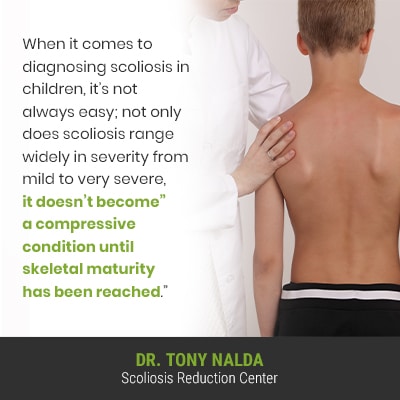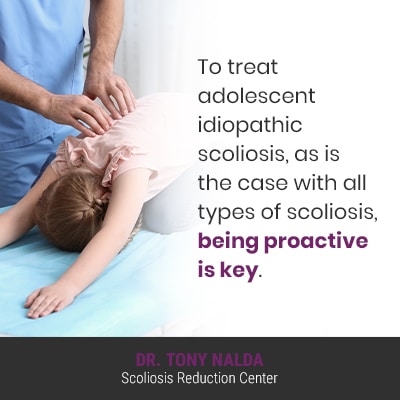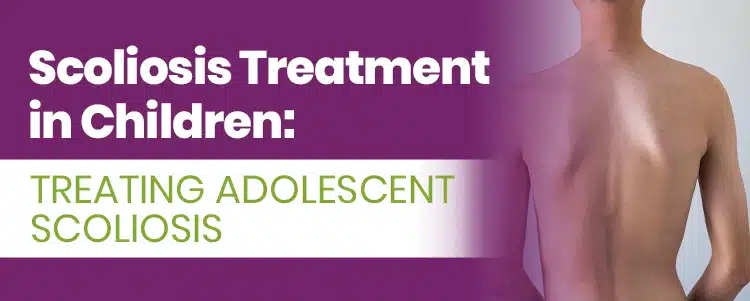Scoliosis can be a complex condition to treat, not only because it ranges so widely in severity, but also because there are multiple condition types, and scoliosis affects all ages. Continue reading to learn which age group is most often diagnosed with scoliosis.
Although scoliosis affects all ages, it’s most commonly diagnosed in adolescents between the ages of 10 and 18 as adolescent idiopathic scoliosis (AIS). Treating adolescent scoliosis means working towards a curvature reduction, and holding it there despite the constant trigger of growth.
Scoliosis affects all ages but is most commonly diagnosed during adolescence, so let’s start with how a doctor diagnoses scoliosis in children.
Diagnosing Scoliosis in Children
Scoliosis is the leading spinal condition amongst school-aged children, and current estimates have close to seven million people currently living with scoliosis in the United States alone.

When it comes to diagnosing scoliosis in children, it’s not always easy; not only does scoliosis range widely in severity from mild to very severe, it doesn’t become a compressive condition until skeletal maturity has been reached.
It’s compression of the spine and its surrounding muscles and nerves that causes the majority of condition-related pain, so as scoliosis isn’t overly painful for children, and functional deficits are rare in mild cases, it can be difficult to detect.
Even the early postural changes that scoliosis causes can be subtle and difficult for anyone, other than an expert trained in the condition’s subtle early signs, to notice.
While there are no treatment guarantees, scoliosis that is diagnosed and treated early in the conditions progressive line (mild, moderate, severe, and very severe) is generally more responsive to treatment.
Scoliosis progressing means the size of the unnatural spinal curve is increasing, and this makes the spine more rigid and less responsive to treatment, and in addition, a muscle imbalance can also get worse with progression as the unnaturally-curved spine pulls its surrounding muscles in different directions.
Basically, it’s far more effective to proactively work towards preventing progression and increasing condition effects, than it is to attempt to work towards reversing those effects once they’re established.
What’s most important is understanding that as a progressive condition, scoliosis has it in its nature to worsen over time, and as the condition’s progressive trigger is growth, children are at risk for rapid-phase progression because of the stage of growth they are in.
Scoliosis can affect children of all ages, but as it’s most commonly diagnosed in adolescents, let’s start there.
Treating Adolescent Idiopathic Scoliosis
Adolescent idiopathic scoliosis is the most prevalent type of scoliosis, and it’s diagnosed between the ages of 10 and 18.
The idiopathic designation means not clearly associated with a single-known cause; idiopathic scoliosis is thought, instead, to be multifactorial, meaning caused by a number of variables that can change from person to person.
One thing I do remind my patients is that knowing the cause of idiopathic scoliosis wouldn’t necessarily change the course of treatment, nor how successful it is; the most important factor is how a diagnosis of scoliosis is responded to with treatment.
What we do understand, however, is what causes scoliosis to progress: growth and development.
Considering the stage of puberty that adolescents are in, or are entering into, and the risk of rapid-phase progression, a large focus of treatment is on counteracting the condition’s progressive nature.

To treat adolescent idiopathic scoliosis, as is the case with all types of scoliosis, being proactive is key.
Scoliosis is simpler to treat when it’s mild, before significant progression has occurred, the spine has become increasingly rigid, making it less responsive to treatment, and before the body has had ample time to adjust to the unnatural spinal curve’s presence.
As children are constantly growing, scoliosis isn’t compressive for them, so pain management is not a common focus of treating adolescent scoliosis, but is when treating adult scoliosis.
When it comes to proactively treating adolescent idiopathic scoliosis, we’re talking about the kind of treatment offered here at the Scoliosis Reduction Center®: a non-surgical scoliosis treatment center.
Conservative Chiropractic-Centered Scoliosis Treatment in Children
When it comes to being proactive, this means starting treatment as close to the time of diagnosis as possible because as a progressive condition, where a scoliosis is at the time of diagnosis isn’t indicative of where it will stay.
Only proactive treatment can work towards counteracting the condition’s progressive nature, and conservative treatment integrates multiple scoliosis-specific treatment disciplines so conditions can be impacted on every level.
Chiropractic care involves a series of techniques and manual adjustments that work towards realigning the curve’s most-tilted vertebrae, at its apex, with the rest of the spine, and this is how a curvature reduction on a structural level can be achieved.
After I start to see structural results, physical therapy can help work towards increasing patients’ core strength so the spine is optimally supported by its surrounding muscles, and it can also help improve posture, in addition to activating certain areas of the brain for improved brain-body communication.
Particularly effective on growing spines, a regular facet of scoliosis treatment in children is corrective bracing that can help augment corrective treatment results by pushing the spine into a corrective position, and I opt for the ultra-corrective ScoliBrace to meet my patients’ bracing needs
Further stabilizing and healing the spine is facilitated by a home-rehabilitation program that involves the prescription of a series of scoliosis-specific exercises and stretches.
Now, while adolescent idiopathic scoliosis is the most common type, it does affect children of all ages, and when it comes to how to help a child with scoliosis, the answer is always proactive treatment.
Scoliosis in Young Children
As mentioned, scoliosis affects all ages, and one of the first steps to treating scoliosis effectively is further classifying conditions based on key patient/condition variables, one of which is patient age, so let’s address the condition at each stage of childhood, leading up to adolescent idiopathic scoliosis.
Congenital scoliosis is a rare form affecting approximately 1 in 10,000, and babies are born with the condition because it’s caused by a malformed spine that develops in utero; conservative treatment involves close monitoring and carefully modifying treatment plans to address the unique challenges associated with treating patients of such a young age.
Infants between the ages of 6 months and 3 years old diagnosed with scoliosis are classified as infantile scoliosis, followed by early-onset juvenile scoliosis diagnosed between the ages of 3 and 10 years old.
When it comes to treatment, my early-onset juvenile scoliosis patients are the ones I can often make the biggest impact with because they have not yet had their first pubescent growth spurt, known to cause quick progression.
And next, we have AIS, followed by adult scoliosis diagnosed after skeletal maturity has been reached.
When it comes to scoliosis treatment for children, monitoring for progression is a focus, as is proactive treatment that allows my young patients to benefit from accessing multiple forms of treatment under one roof.
Conclusion
Again, while I can never give treatment guarantees, in my young patients who are diagnosed early and their diagnosis is responded to with a proactive conservative treatment plan, there are fewer limits to what can be achieved.
The most important characteristic of scoliosis to understand, particularly in children, is that as a progressive condition, virtually every case is going to get worse at some point, and as growth triggers progression and increasing condition effects, the best time to start treatment to help a child with scoliosis is always now.
The condition’s most common type is adolescent idiopathic scoliosis, diagnosed between the ages of 10 and 18, and the rapid and unpredictable growth spurts of puberty put this age group at risk for rapid-phase progression.
The goal of treating adolescent scoliosis is to achieve a curvature reduction, but to also hold that reduction throughout growth.
For children, scoliosis doesn’t tend to involve a lot of back pain, and this is because the condition doesn’t become compressive until adulthood, and this can make it difficult to detect.
Early signs of scoliosis in children to watch for can include uneven shoulders, shoulder blades, the development of a rib arch, uneven hips, and arms and legs that appear to hang at different lengths, and this is because the condition’s uneven forces disrupt the body’s overall symmetry.
Additional signs to watch for are changes to balance, coordination, gait, and clothing suddenly seeming ill-fitting.
Here at the Center, I proactively treat my young patients to help prevent progression, increasing condition effects, and the need for invasive spinal surgery in the future.




